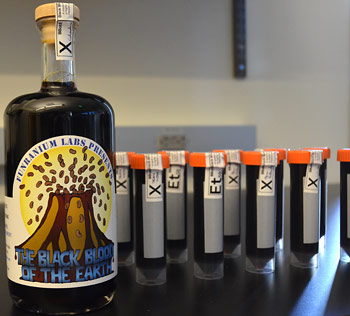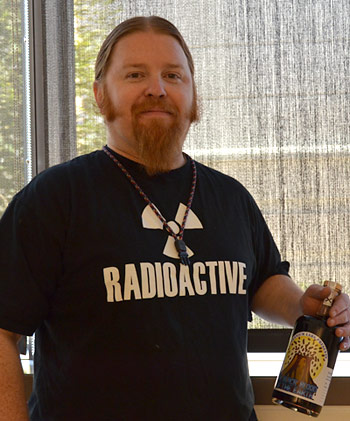Brewmeister savors buzz of extreme science
Diagnosed with Type II diabetes, Phil Broughton's polymath mind and tinkering tendencies spurred the radiation safety specialist to dive headlong into the chemistry of coffee to tame his vicious sweet tooth.

November 13, 2012
“Persons of Interest” is a weekly series exploring the lives of students, staff and faculty, both on- and off-campus.
 BERKELEY — When Phil Broughton was diagnosed with Type II diabetes in 2009, an overwhelming sense of dread engulfed the 34-year-old campus staffer.
BERKELEY — When Phil Broughton was diagnosed with Type II diabetes in 2009, an overwhelming sense of dread engulfed the 34-year-old campus staffer.
Unfazed by the potential perils of working with radioactive materials, the radiation safety specialist shuddered at the realization that he must break off his lifelong love affair with a certain sugar-spiked cola — over the years, Broughton’s childhood taste for fizzy drinks had morphed into a “six-pack-a-day soda habit.”
“Even more than the sugar, I was freaking out about how I’d get my caffeine fix because fatigue was a big problem,” recalls Broughton, whose long, demanding workdays were stretched by several hours in commuter traffic. “I needed the extra energy to help me focus and get through the day.”
Finding regular coffee-shop offerings bitterly unpalatable unless doctored with lashings of cream and sugar — not an option — Broughton’s polymath mind and tinkering tendencies spurred him to dive headlong into the art and chemistry of coffee to create his very own bean brew.
After 12 months of trial and error, Broughton perfected a cold-vacuum extraction process that takes up to 96 hours and uses six times more beans than conventional hot-drip brewing methods.

“Black Blood of the Earth” delivers a super-concentrated caffeine fix roughly 40 times that of regular coffee. (Roibín Ó hÉochaidh photos)
He christened his new elixir “Black Blood of the Earth.”
While your typical eight-ounce cup of coffee contains roughly 120 milligrams of caffeine, Black Blood delivers a high-octane caffeine jolt roughly 40 times that of garden-variety drip coffee by volume, according to its creator’s back-of-the-envelope calculations.
“The goal of my experiment was to concentrate the natural oils from the beans for maximum flavor, minimizing acidity and bitterness,” he says. “Hypercaffeination was just a nice bonus.”
“Black Blood” is now available in a handful of varietals, including “Death Wish,” which his bean supplier boasts is the most highly caffeinated, dark roast, organic coffee in the world.
Broughton’s Funranium Labs website is routinely bombarded with refill orders from frenzied devotees coast to coast and regularly sends shipments to some 20 countries around the world.
In the interests of safety, and perhaps sanity, Broughton recommends consuming no more than 3.5 ounces of the coffee nectar per day, which in coffeehouse terms is roughly equivalent to a standard shot of espresso.
“Normally, I dilute mine three parts hot water to one part coffee, which makes it last long enough for me to take care of my morning email,” he says.
When he isn’t brewing up a storm, Broughton spends his campus workdays monitoring the use of radioactive materials and radiation-producing equipment, such as X-ray machines and particle accelerators, ensuring that staff are properly trained and detection instrumentation is maintained in good working order.
“When you come across something strange in back of a storage closet or some long-vacated room is setting of your radiation detector for no apparent reason, I’m the person you call to come take a look and solve the mystery,” Broughton says.

Diagnosed with Type II diabetes, radiation safety specialist Phil Broughton crafted “Black Blood” to help tame his “vicious” sweet tooth.
Born within earshot of NASA’s rocket-program launching pad in Cape Canaveral, extreme science has long been a way of life for Broughton.
Growing up in the Santa Cruz Mountains after his parents followed the semiconductor boom to Silicon Valley, he studied physics at UC Santa Cruz before earning a master’s in health physics from Oregon State.
“I got into all sorts of stuff as a kid and had plenty of misadventures while exploring the world around me,” Broughton says. “But if you don’t question, if you don’t tinker, then you don’t think about or discover the possibilities of what can be.”
In 2002, Broughton jumped at a yearlong research opportunity to work as a cryogenics technician at Amundsen-Scott South Pole Station in Antarctica. Blending work and play, he ended up moonlighting as the station’s bartender with experiments that stretched to liquid-nitrogen cocktails.
Before joining Berkeley’s Office of Environment, Health and Safety, his work with nuclear materials at Lawrence Livermore National Lab rendered him an “informed person” — the sensitive information knocking around his brain governed by national-security protocols until his last breath.
Today, he continues to work at Lawrence Livermore, schooling grad-student researchers in radiation-safety protocols while devoting one evening a week to teaching radiation safety at Las Positas Community College in Pleasanton. On occasion, he also conducts training sessions with UCPD’s bomb squad.
Although his work schedule remains as demanding as ever, Broughton, whose father’s diabetic condition went unnoticed for many years, is happy to report that his diabetes is under control — through a combination of medication, lifestyle and diet changes and a little help from “Black Blood of the Earth.”
“I saw the damage it caused with my dad and I saw my future, so I made some big changes to avoid the big problems waiting down the line,” he says.
Know a member of the campus community — staff, student or faculty — who might make a good subject for “Persons of Interest”? Send us a note at [email protected].